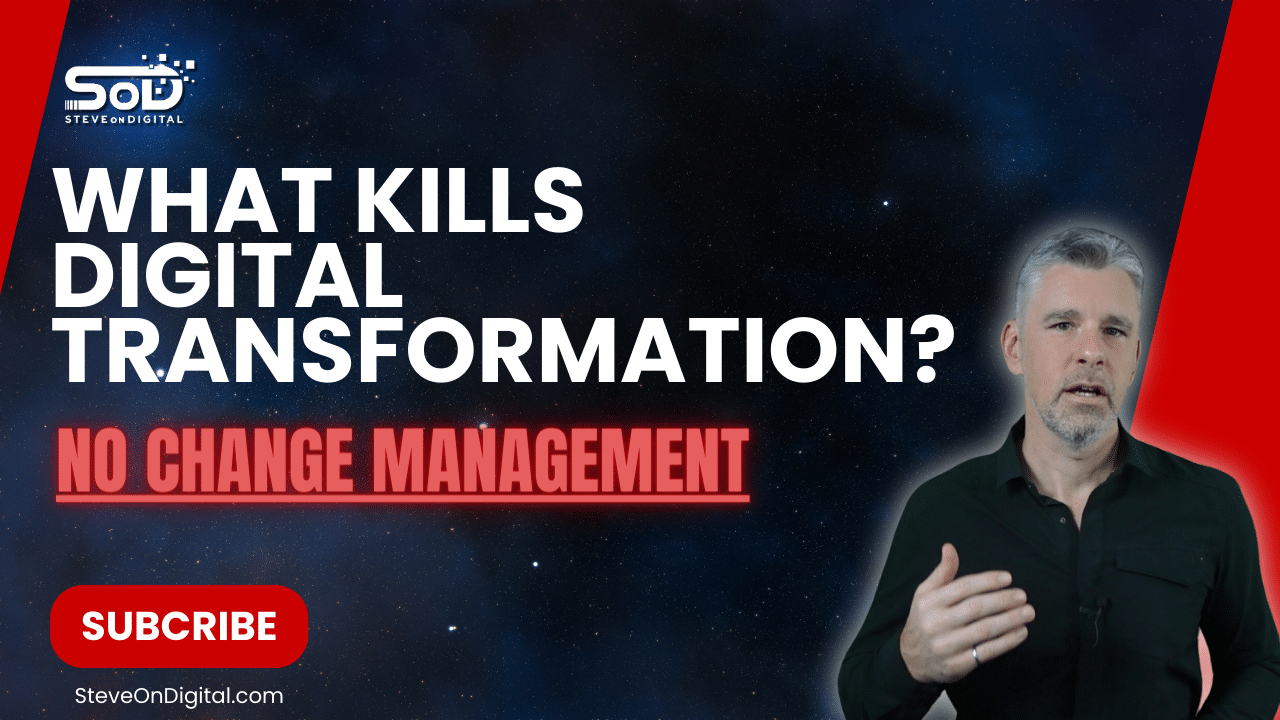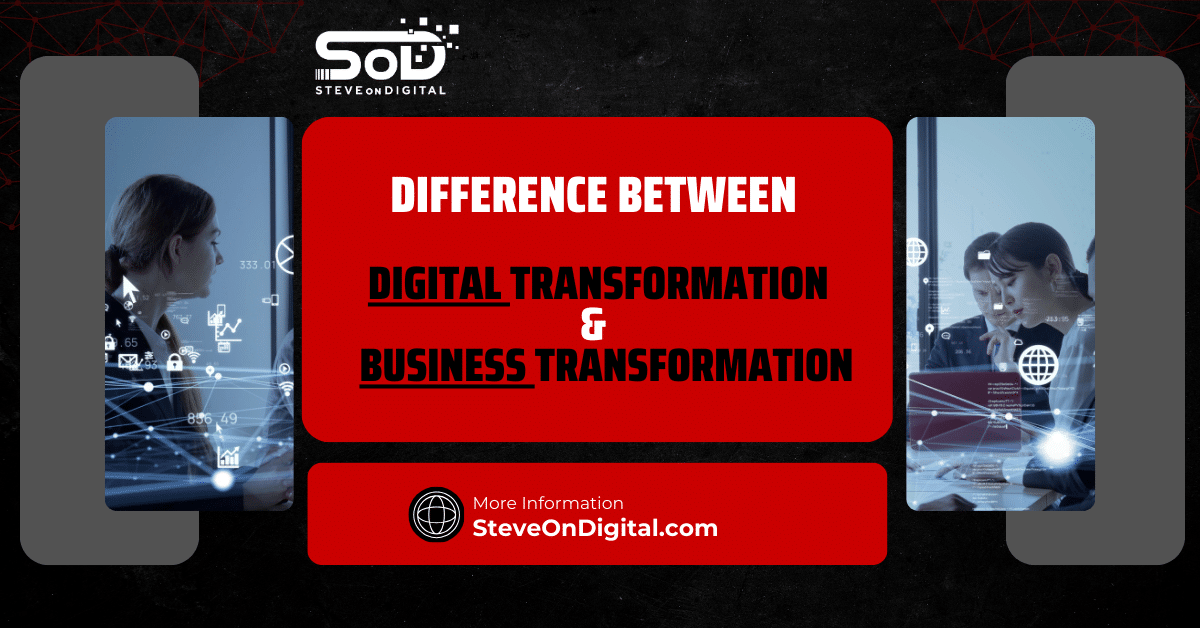Change management is crucial for the success of any digital transformation. It involves guiding people through organizational changes to ensure smooth implementation and long-term success. Without effective change management, even the best digital transformation initiatives can fail.
Digital transformation requires more than just new technology; it demands a shift in how a business operates, its processes, and its culture. By focusing on change management, I can help organizations adapt to new digital tools, overcome resistance, and achieve lasting success in the digital age.
I’m Steve, a digital transformation expert with a strong background in electrical engineering, an MBA, and a master’s in Project Management. I excel at helping SMEs navigate the digital landscape with practical insights. Let’s begin!
Understanding Digital Transformation
Digital transformation is more than just a buzzword; it’s a business imperative. As technology evolves, so too must the way we do business. Digital transformation is the process of incorporating digital technologies across every aspect of a business, leading to significant changes in how the organization functions and delivers value to its customers. But to do this successfully, a structured and systematic approach is essential.
The Need for Digital Transformation
Let’s face it, the digital era is here, and it’s not waiting for anyone. Companies that fail to embrace digital transformation risk falling behind their competitors. Technological advancements, such as artificial intelligence and cloud computing, are driving businesses to innovate and optimize their operations. Moreover, customer expectations have shifted; they now demand seamless, personalized experiences, which can only be delivered through digital means. This makes digital transformation not just a choice, but a necessity for survival and growth.
Key Components of Digital Transformation
Digital transformation is a multifaceted process that touches every part of an organization. At its core, it involves adopting new technologies and integrating them into existing business processes. This often requires organizational restructuring, where new business models are developed to better align with the digital tools and strategies being implemented. These changes are not just about technology; they’re about rethinking how your business operates and how you can create more value for your customers.
Common Challenges in Digital Transformation
Despite its importance, digital transformation is no walk in the park. Many organizations face significant challenges, from resistance to change to technological hurdles. Resistance often stems from fear—fear of the unknown, fear of losing jobs, or simply fear of change itself. Technological challenges, on the other hand, can include anything from integrating new systems with existing ones to ensuring data security in the digital age. These obstacles can derail even the most well-planned digital transformation projects if not addressed properly.
The Role of Change Management in Digital Transformation
Now, let’s talk about the role of change management in digital transformation. Without a solid change management strategy, even the most promising digital transformation initiatives can fail. Change management is about more than just managing change; it’s about guiding your entire organization through a journey of transformation, ensuring that every employee is on board and that the changes are sustainable.
Importance of a Comprehensive Change Management Strategy
A comprehensive change management strategy is essential for navigating the complexities of digital transformation. This strategy should include clear communication, continuous support, and a structured approach to managing change. It’s about setting expectations, providing the necessary tools and resources, and ensuring that everyone in the organization understands and embraces the changes. This approach not only helps in achieving a smooth transition but also plays a crucial role in the overall success of the digital transformation.
Change Management Versus Project Management
It’s important to distinguish between change management and project management, as the two are often confused. While project management focuses on the technical side of implementing new processes and technologies, change management is all about the people. It’s about addressing the human side of change, ensuring that employees understand, accept, and support the new ways of working. Both are essential to digital transformation, but they serve different purposes.
Benefits of Effective Change Management
Effective change management brings numerous benefits. It increases employee engagement by making them feel involved and valued during the transformation process. This, in turn, leads to higher productivity and better business value. Moreover, a well-executed change management strategy can reduce the risk of failure, ensuring that the transformation is not just a one-time event but an ongoing process that drives continuous improvement and innovation.
Developing a Change Management Strategy
Creating a successful change management strategy is like plotting a course for a long journey—without a map, you’re bound to get lost. When it comes to digital transformation projects, this strategy becomes your guiding star. I’ve learned firsthand that having a clear plan not only helps to navigate through the complexities but also ensures everyone is on the same page. It’s about setting clear objectives, assessing readiness, and making sure leadership is actively engaged.
Setting Clear Objectives and Vision
When embarking on a digital transformation, the first step is to set clear objectives and a compelling vision. This isn’t just about where you want to go, but why you’re going there. From my experience, a clear vision acts as the anchor for the entire process. It aligns the team and keeps everyone focused on the end goal. In practical terms, this means defining what success looks like—whether it’s improving key performance indicators (KPIs), enhancing customer experiences, or streamlining business processes. These objectives should be specific, measurable, and tied directly to the overall business strategy.
Assessing Organizational Readiness
Before diving into any transformation, I always make it a point to assess the organization’s readiness. This involves taking a close look at the existing business processes and the current company culture. Are your processes outdated, or can they be easily adapted to new technologies? Is your company culture open to change, or are you likely to face resistance? Understanding where you stand is crucial for identifying potential roadblocks early on. This assessment isn’t just a one-time check; it’s an ongoing process that should be revisited as the transformation progresses.
Engaging Leadership and Stakeholders
Leadership and stakeholder engagement is where many transformations either succeed or fail. I’ve seen it time and again—when leaders are visibly committed to the change, the rest of the organization follows. This doesn’t mean just paying lip service; it means actively driving the change. Leaders should communicate the vision, set expectations, and most importantly, listen to feedback. Stakeholder buy-in is equally crucial, as they often hold the keys to the resources and support needed to drive change. Engaging them early and often can make the difference between a smooth transition and one fraught with obstacles.
Communication in Change Management
Communication is the lifeblood of change management, especially during digital transformation. Without clear and consistent communication, even the best-laid plans can falter. From my perspective, it’s not just about what you communicate, but how and when you do it. Effective communication helps to reduce uncertainty, build trust, and keep everyone aligned.
Developing a Communication Plan
A well-structured communication plan is essential for keeping everyone informed and engaged throughout the transformation. This plan should outline what needs to be communicated, to whom, and through which channels. For instance, I’ve found that a mix of email updates, face-to-face meetings, and digital platforms works best. The key is to ensure that the message is clear and that it reaches everyone who needs to hear it. The communication plan should also include timelines and key milestones to keep the momentum going.
Clear Communication of Benefits and Challenges
It’s important to be upfront about both the benefits and challenges of the transformation. People are more likely to support the change if they understand what’s in it for them. I always make it a point to highlight the positive outcomes—such as enhanced digital tools, improved business value, or greater job satisfaction—while also addressing the challenges head-on. This transparency not only builds trust but also helps to manage expectations. After all, no transformation is without its bumps in the road, and acknowledging this can help to prepare the team for what’s ahead.
Continuous Feedback and Communication
Change is not a one-time event but an ongoing process, and so should be your communication. Continuous feedback loops are critical for identifying issues early and making necessary adjustments. I’ve found that regular check-ins, surveys, and open forums where employees can voice their concerns are invaluable. This ongoing dialogue not only helps to address any emerging issues but also fosters a culture of continuous improvement. By keeping the lines of communication open, you can adapt to changes more effectively and keep the transformation on track.
Training and Support During Digital Transformation
No digital transformation can succeed without proper training and support. Employees need to be equipped with the right skills and knowledge to adapt to new technologies and processes. From my experience, the training doesn’t stop after the initial rollout; it’s an ongoing effort to ensure that everyone is comfortable and proficient with the changes.
Identifying Skills Gaps
The first step in training is to identify any skills gaps that might hinder the transformation. This involves assessing the current skill levels of employees and determining where additional training is needed. For example, if new digital tools are being introduced, do your employees have the necessary technical skills to use them effectively? I’ve always found it helpful to conduct a skills audit early in the process to pinpoint these gaps. Once identified, these gaps can be addressed through targeted training programs.
Designing Effective Training Programs
Effective training programs are those that are relevant, practical, and tailored to the specific needs of the organization. It’s not enough to offer generic training; it needs to be directly applicable to the tasks employees will be performing. In my experience, hands-on training that simulates real-world scenarios is the most effective. It helps employees to understand how the new processes and tools will impact their day-to-day work and allows them to practice in a safe environment before going live.
Providing Ongoing Support
Training shouldn’t end once the initial sessions are over. Providing ongoing support is crucial for ensuring that employees continue to grow and adapt to the new environment. This can include access to training materials, one-on-one coaching, and a helpdesk for any issues that arise. I always ensure that there are resources available for employees to refer back to, whether it’s through online tutorials, user manuals, or dedicated support teams. Continuous support not only helps to solidify the training but also encourages a culture of continuous learning and improvement.
Implementing Change Management Strategies
Putting change management strategies into practice is where the rubber meets the road in digital transformation initiatives. I’ve found that it’s not enough to have a solid plan; the real challenge lies in execution. Successful implementation requires careful timing, ongoing adjustments, and learning from both successes and setbacks. It’s like running a marathon—steady, consistent effort is key, and pacing yourself will help you reach the finish line without burning out.
Phased Implementation Approach
One of the most effective strategies I’ve used is a phased implementation approach. Rather than trying to roll out all changes at once, which can overwhelm employees and disrupt business processes, breaking the process into manageable phases allows for gradual adaptation. This method gives everyone time to adjust to each new phase, reducing resistance and minimizing disruptions to ongoing operations. I’ve noticed that when changes are introduced incrementally, employees are more likely to embrace change because they have time to understand and adapt to the new processes.
Monitoring Progress and Adjusting Strategies
Monitoring progress is crucial to ensure that the change management efforts are on track. Throughout my career, I’ve learned that what gets measured gets managed. By keeping a close eye on key performance indicators (KPIs) and gathering regular feedback from employees, I can spot potential issues early and make necessary adjustments before they become major problems. This proactive approach helps to keep the transformation moving forward smoothly. Adjusting strategies based on real-time data and feedback not only improves the effectiveness of the change management process but also demonstrates to employees that their input is valued and acted upon.
Celebrating Successes and Learning from Failures
Acknowledging and celebrating successes, no matter how small, can have a huge impact on morale and motivation. I make it a point to celebrate milestones and achievements during the transformation process. This not only boosts morale but also reinforces the value of the changes being implemented. On the flip side, it’s equally important to learn from failures. In my experience, failures provide some of the best learning opportunities. By analyzing what went wrong, I can refine the process and improve future outcomes. It’s about turning setbacks into stepping stones, using each one to build a stronger, more resilient organization.
Measuring the Success of Change Management
Measuring the success of change management is essential to understanding the impact of the digital transformation. It’s not just about checking off a list of completed tasks; it’s about evaluating whether the changes have delivered the desired results. In my experience, this requires a combination of quantitative metrics and qualitative insights.
Key Performance Indicators (KPIs) for Change Management
KPIs are the backbone of any measurement strategy. They provide a clear, objective way to assess the success of the change management efforts. For digital transformation, I typically focus on KPIs that reflect improvements in business processes, employee engagement, and overall business value. These might include metrics like the adoption rate of new technologies, improvements in customer experiences, or increases in efficiency and productivity. Tracking these KPIs over time allows me to gauge the effectiveness of the changes and make data-driven decisions about any further adjustments that might be needed.
Qualitative and Quantitative Evaluation
While KPIs provide the hard data, qualitative feedback offers the context behind the numbers. In my experience, combining both quantitative and qualitative evaluations gives a more complete picture of the transformation’s success. Quantitative data might tell you that a new process has reduced costs, but qualitative feedback can reveal whether employees find the process more efficient or whether customers are happier with the service they receive. This dual approach ensures that the change management process is not just effective on paper but is also creating a positive impact on the ground.
Continuous Improvement Based on Insights
Continuous improvement is the hallmark of successful change management. It’s not enough to implement changes and move on; the process must be ongoing, with regular reviews and adjustments based on insights gathered from the KPIs and feedback. I’ve always believed in the power of iterative improvement—using each round of evaluation to refine strategies and processes. This approach helps to keep the organization agile, ready to adapt to new challenges and opportunities as they arise. It’s about creating a culture of continuous learning and development, where change is seen not as a one-time event but as a continual journey.
Case Studies of Successful Change Management in Digital Transformation
Learning from real-world examples can provide invaluable insights into what works—and what doesn’t—in change management. Over the years, I’ve studied and been involved in numerous digital transformation projects, each offering unique lessons.
Case Study 1: Digital Transformation in a Manufacturing Firm
One of the most compelling examples comes from a manufacturing firm that successfully navigated its digital transformation by focusing on a comprehensive change management strategy. The company faced significant challenges, including resistance to adopting new digital tools and the need for significant organizational restructuring. By implementing a phased approach and maintaining clear, consistent communication, the company was able to drive change effectively. The result was not only a more efficient operation but also a more engaged and empowered workforce, demonstrating the power of a well-executed change management strategy.
Case Study 2: Change Management in a Service Industry
In the service industry, where customer experience is paramount, change management takes on an added level of importance. I worked with a service company that needed to overhaul its entire customer service process as part of its digital transformation. By engaging employees early and providing extensive training and support, the company was able to transition smoothly to a new, more efficient system. The key to success in this case was the continuous feedback loop, which allowed the company to make adjustments in real-time and ensure that the new system was meeting both employee and customer needs.
Lessons Learned from Successful Case Studies
The lessons from these case studies are clear: successful change management requires a structured and systematic approach, continuous monitoring and adjustment, and a strong focus on communication and support. It’s about creating a roadmap for change that is flexible enough to adapt to unforeseen challenges but robust enough to guide the organization toward its goals. By learning from these examples, other organizations can apply similar strategies to their own digital transformation projects, increasing their chances of success.
Overcoming Resistance to Change
Resistance to change is one of the most common hurdles in any digital transformation initiative. I’ve seen it time and again—employees are often wary of change, especially when it disrupts their daily routines or challenges their existing skills. But understanding the root causes of resistance can help in developing strategies to overcome it. It’s not just about pushing through; it’s about addressing concerns, involving employees in the process, and building a supportive organizational culture.
Understanding the Root Causes of Resistance
Resistance usually stems from fear—fear of the unknown, fear of losing control, or fear of failure. Employees might worry about their job security if new technologies replace old processes. They might feel overwhelmed by the need to learn new skills or fear that they won’t be able to keep up. By identifying these underlying concerns, I can address them directly. For instance, offering reassurance about job security or providing clear, step-by-step training can help alleviate these fears. Understanding these root causes allows me to craft a more empathetic and effective change management strategy.
Engaging Employees in the Change Process
One of the most effective ways to reduce resistance is to involve employees in the change process. In my experience, people are more likely to embrace change when they feel like they have a voice in how it’s implemented. This means engaging employees early and often, seeking their input, and listening to their concerns. By doing this, I can build a sense of ownership and commitment to the change. This might involve setting up workshops, feedback sessions, or even pilot programs where employees can test new processes before they’re rolled out across the entire organization. Engaging employees not only reduces resistance but also improves the overall success of the digital transformation.
Building a Supportive Organizational Culture
Creating a supportive organizational culture is essential for embracing change. I’ve learned that when the company culture is open to innovation and continuous improvement, employees are more likely to see change as a positive development rather than a threat. This involves cultivating an environment where learning and growth are encouraged, where employees feel safe to take risks and make mistakes, and where success is celebrated. It’s about making change a part of the organizational DNA. This kind of culture doesn’t just help in overcoming resistance to a single change initiative; it makes the organization more resilient and adaptable in the long run.
The Future of Change Management in Digital Transformation
As digital transformation continues to evolve, so too must our approach to change management. The future will be shaped by emerging trends like artificial intelligence (AI) and automation, which are already beginning to reshape the workplace. At the same time, there’s a growing need for agility and adaptability in how we manage change. The pace of technological advancements is not slowing down, which means that continuous change management efforts will be essential for staying ahead.
The Role of Artificial Intelligence and Automation
AI and automation are no longer just buzzwords—they’re becoming integral parts of how businesses operate. These technologies are transforming everything from customer service to data analysis, and they’re also having a significant impact on change management. For instance, AI can be used to analyze employee feedback and predict potential resistance to change, allowing me to address issues before they become problems. Automation can streamline the implementation of new processes, reducing the workload on employees and making it easier for them to adapt. However, these technologies also bring challenges, particularly in ensuring that employees are equipped with the skills they need to work alongside AI and automated systems.
The Importance of Agility in Change Management
Agility is becoming increasingly important in managing change. In today’s digital era, where change is constant, being able to adapt quickly is crucial. Traditional, rigid change management strategies are no longer sufficient. Instead, I focus on creating flexible strategies that can be adjusted as new challenges and opportunities arise. This might involve using agile project management techniques, which allow for continuous feedback and iteration, or adopting a mindset of continuous improvement, where the focus is on learning and evolving rather than sticking to a fixed plan. Agility in change management helps organizations stay competitive and responsive in a rapidly changing digital landscape.
Preparing for Continuous Digital Transformation
Digital transformation isn’t a single event; it’s an ongoing journey that demands continuous change management and adaptation. As new technologies emerge and business environments evolve, organizations must be prepared to adapt. This means not only implementing changes as they come but also fostering a culture of continuous learning and improvement. From my experience, this involves staying ahead of industry trends, investing in employee development, and constantly reevaluating and refining business processes. Preparing for continuous digital transformation ensures that the organization remains resilient and competitive in the digital age.
Final Thoughts
Change management is the cornerstone of successful digital transformation. Without it, even the best digital transformation initiatives can fail. But with a comprehensive change management strategy—one that involves setting clear objectives, engaging employees, and fostering a supportive culture—organizations can navigate the complexities of digital transformation and achieve lasting success. As the digital landscape continues to evolve, so too must our approach to change management. By staying agile, embracing new technologies, and committing to continuous improvement, we can ensure that our organizations are not just surviving but thriving in the digital era.




